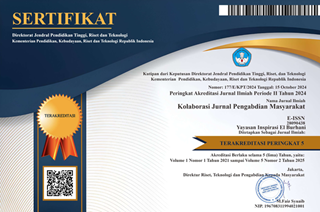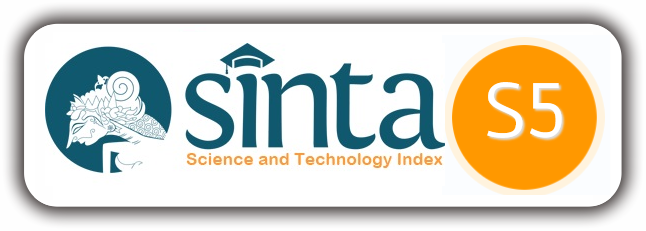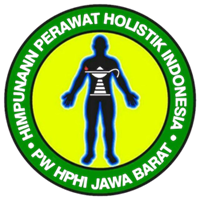Permainan Ular Tangga untuk Edukasi Disiplin Membuang Sampah
DOI:
https://doi.org/10.56359/kolaborasi.v2i1.37Kata Kunci:
Trash, Snakes and Ladders, GamesAbstrak
Introduction: Instilling awareness to maintain a clean environment can be instilled from an early age. The application or delivery of health promotion can use game media because students can more easily understand, not experience boredom in delivering the material. Health education media that can be applied to school children are like the snake and ladder game.
Objective: To implement snake and ladder games on increasing students' knowledge in disposing of waste.
Method: Health promotion research is used in PHBS education methods and demonstrations of disposing of waste according to its type with game media in the form of snakes and ladders. This Health Promotion was carried out with 8 students who were at SDN 3 Linggasari, Ciamis District, Ciamis Regency with a total of 25 children as respondents and accompanied by a homeroom teacher. Health Promotion is carried out through 4 stages, namely 1) selection of targets and places, 2) preparation of facilities and infrastructure, 3) implementation of activities, 4) evaluation.
Result: The implementation of health promotion for students of SDN 3 Linggasari Ciamis on Clean and Healthy Living Behavior about Disposing of garbage according to its type produced less significant results because previously students of SDN 3 Linggasari Ciamis rarely applied it so that there were still students who could not distinguish between organic and non-organic types of waste, and dispose of waste improperly.
Conclusion: This activity can increase children's knowledge about the purpose of disposing of waste, the benefits of disposing of waste in its place, the positive and negative impacts of throwing garbage in its place, as well as steps for disposing of waste correctly. In its implementation in the field, teachers and children at SDN 3 Linggasari Ciamis gave a positive response and high enthusiasm in participating in counseling and simulations of disposing of waste according to its type.
Unduhan
Referensi
Fiantis, D. (1967). Pengaruh Pendidikan Kesehatan Tentang PHBS Dengan Media Permainan Ular Tangga Dan Ceramah Terhadap Pengetahuan Siswa Sd Negeri Limpakuwus Kabupaten Banyumas Tahun 2017 Annisa Nurhidayati *) , Nur Hilal **). Angewandte Chemie International Edition, 6(11), 951–952., 5–24.
Firman, F., & Maisyarah, E. (2019). Media Permainan Ular Tangga, Motivasi Dan Hasil Belajar Peserta Didik Di Sekolah Dasar. https://doi.org/10.31227/osf.io/46prn
Firmansyah, A., Setiawan, H., Suhanda, S., Fitriani, A., & Roslianti, E. (2018). Pendidikan Kesehatan kepada Keluarga “Perawatan Luka Pasca Khitan Metode Konvensional yang Optimal.” ABDIMAS: Jurnal Pengabdian Masyarakat, 1(2), 53–56.
Nurhidayat, N., Suhanda, S., Setiawan, D., Ariyanto, H., & Setiawan, H. (2021). Health Promotion with Counseling on Fulfilling Balanced Nutritional Needs for Community Groups in Pandemic Covid-19 Outbreak. ABDIMAS: Jurnal Pengabdian Masyarakat, 4(2), 853–860. https://doi.org/10.35568/abdimas.v4i2.1424
Nurhidayati, A. (2017). Pengaruh Pendidikan Kesehatan Tentang Phbs Dengan Media Permainan Ular Tangga Dan Ceramah Terhadap Pengetahuan Siswa Sd Negeri Limpakuwus Kabupaten Banyumas Tahun 2017 Annisa Nurhidayati *) , Nur Hilal **), 37(3), 332–338.
Pritananda, jihan ayu alip. (2018). Pengaruh Perilaku Masyarakat Membuang Sampah di Sungai. https://doi.org/10.31219/osf.io/d3xv6
Setiawan, H., Khairunnisa, R. N., & Oktavia, W. (2021). Handwashing Health Education to Prevent Covid-19 Transmission in SMP Inspirasi. ABDIMAS: Jurnal Pengabdian Masyarakat, 4(1), 428–432.
Suhanda, S., Lismayanti, L., Nurjanah, N., Setiawan, H., & Kurniawan, R. (2018). Pelaksanaan Five Moment Cuci Tangan Perawat Di Ruang Rawat Inap Rumah Sakit Umum Daerah Kabupaten Ciamis. Jurnal Kesehatan STIKes Muhammadiyah Ciamis, 5(1), 72–87.
Hamdani, D., Setiawan, H., & Firmansyah, A. (2022). Perilaku Hidup Bersih dan Sehat Dalam Pencegahan Penyakit Cikungunya Pada Pelajar. Jurnal Pengabdian Masyarakat Saga Komunitas, 1(1), 21-25.












